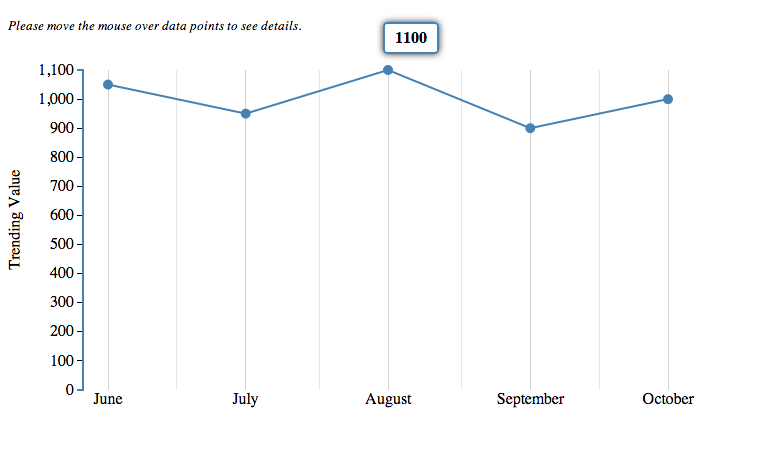Line Charts with d3 js
Want to do a line chart with d3? There are no ready APIs right? At least none that I could find. What I did find was http://benjchristensen.com/2012/05/02/line-graphs-using-d3-js/ (very useful!) and I hacked up a line chart taking cue from there.
Here’s an example:
And the code?
<!DOCTYPE html>
<html lang="en">
<head>
<title>Line Charts</title>
<script src="http://code.jquery.com/jquery-1.8.2.min.js"></script>
<script src="http://d3js.org/d3.v2.js"></script>
<script type="text/javascript">
function getDate(d) {
var dt = new Date(d.date);
dt.setHours(0);
dt.setMinutes(0);
dt.setSeconds(0);
dt.setMilliseconds(0);
return dt;
}
function showData(obj, d) {
var coord = d3.mouse(obj);
var infobox = d3.select(".infobox");
// now we just position the infobox roughly where our mouse is
infobox.style("left", (coord[0] + 100) + "px" );
infobox.style("top", (coord[1] - 175) + "px");
$(".infobox").html(d);
$(".infobox").show();
}
function hideData() {
$(".infobox").hide();
}
var drawChart = function(data) {
// define dimensions of graph
var m = [20, 40, 20, 100]; // margins
var w = 700 - m[1] - m[3]; // width
var h = 360 - m[0] - m[2]; // height
data.sort(function(a, b) {
var d1 = getDate(a);
var d2 = getDate(b);
if (d1 == d2) return 0;
if (d1 > d2) return 1;
return -1;
});
// get max and min dates - this assumes data is sorted
var minDate = getDate(data[0]),
maxDate = getDate(data[data.length-1]);
var x = d3.time.scale().domain([minDate, maxDate]).range([0, w]);
// X scale will fit all values from data[] within pixels 0-w
//var x = d3.scale.linear().domain([0, data.length]).range([0, w]);
// Y scale will fit values from 0-10 within pixels h-0 (Note the inverted domain for the y-scale: bigger is up!)
var y = d3.scale.linear().domain([0, d3.max(data, function(d) { return d.trendingValue; } )]).range([h, 0]);
// create a line function that can convert data[] into x and y points
var line = d3.svg.line()
// assign the X function to plot our line as we wish
.x(function(d, i) {
// return the X coordinate where we want to plot this datapoint
return x(getDate(d)); //x(i);
})
.y(function(d) {
// return the Y coordinate where we want to plot this datapoint
return y(d.trendingValue);
});
function xx(e) { return x(getDate(e)); };
function yy(e) { return y(e.trendingValue); };
$("#chart").append("<p><small><em>Please move the mouse over data points to see details.</em></small></p>");
// Add an SVG element with the desired dimensions and margin.
var graph = d3.select("#chart").append("svg:svg")
.attr("width", w + m[1] + m[3])
.attr("height", h + m[0] + m[2])
.append("svg:g")
.attr("transform", "translate(" + m[3] + "," + m[0] + ")");
// create yAxis
var xAxis = d3.svg.axis().scale(x).ticks(d3.time.months, 1).tickSize(-h).tickSubdivide(true);
// Add the x-axis.
graph.append("svg:g")
.attr("class", "x axis")
.attr("transform", "translate(0," + h + ")")
.call(xAxis);
// create left yAxis
var yAxisLeft = d3.svg.axis().scale(y).ticks(10).orient("left"); //.tickFormat(formalLabel);
// Add the y-axis to the left
graph.append("svg:g")
.attr("class", "y axis")
.attr("transform", "translate(-25,0)")
.call(yAxisLeft);
// Add the line by appending an svg:path element with the data line we created above
// do this AFTER the axes above so that the line is above the tick-lines
graph
.selectAll("circle")
.data(data)
.enter().append("circle")
.attr("fill", "steelblue")
.attr("r", 5)
.attr("cx", xx)
.attr("cy", yy)
.on("mouseover", function(d) { showData(this, d.trendingValue);})
.on("mouseout", function(){ hideData();});
graph.append("svg:path").attr("d", line(data));
graph.append("svg:text")
.attr("x", -200)
.attr("y", -90)
.attr("dy", ".1em")
.attr("transform", "rotate(-90)")
.text("Trending Value");
$("#chart").append("<div class='infobox' style='display:none;'>Test</div>");
}
var draw = function() {
var data = [ {'date': "2012-10-01", 'trendingValue': 1000}, {'date': "2012-09-01", 'trendingValue': 900}, {'date': "2012-08-01", 'trendingValue': 1100}, {'date': "2012-07-01", 'trendingValue': 950}, {'date': "2012-06-01", 'trendingValue': 1050}];
drawChart(data);
}
</script>
<style>
#chart path {
stroke: steelblue;
stroke-width: 2;
fill: none;
}
.axis { shape-rendering: crispEdges; }
.x.axis line { stroke: lightgrey; }
.x.axis .minor { stroke-opacity: .5; }
.x.axis path { display: none; }
.y.axis line, .y.axis path {
fill: none;
stroke: #000;
}
.infobox {
border:2px solid steelblue;
border-radius:4px;
box-shadow:#333333 0px 0px 10px;
margin:200px auto;
padding:5px 10px;
background:rgba(255, 255, 255, 0.8);
position:absolute;
top:0px;
left:0px;
z-index:10500;
font-weight:bold;
}
</style>
</head>
<body onload="draw();">
<div id="chart">
</div>
</body>
</html>
